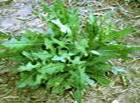BOTANICAL NAME: Lactusa virosa
FAMILY: Asteraceae
ENGLISH NAME: lettuce

HABITAT: include moist to slightly dry black soil prairies, clay prairies, gravel prairies, openings in woodlands, thickets, savannas, lake borders and riverbanks, limestone glades, fence rows, pastures and abandoned fields, powerline clearances, areas along railroads and Close-Up of Lower Leaf roadsides, vacant lots, and miscellaneous waste areas. This plant is more common in degraded prairies and disturbed habitats.
BOTANICAL DESCRIPTION: Wild lettuce is s biennial plant is unbranched and 3-8’ tall. The central stem is round and smooth, light green or reddish green and often glaucous. The alternate leaves are light green to dark green, Wild Lettuce in Woodland Opening sometimes with purple edges or a yellowish cast. They are up to 10” long and 3” across. The largest leaves have deep pinnate lobes, while the smaller leaves have shallow pinnate lobes or none.
AYURVEDIC CHARACTERISTICS:
| RASA | GUNA | VEERYA | VIPAKA | PRABHAVA | DOSHGHNTA |
| Tikta, katu | Laghu, ruksha | Shita | Katu | Vat-pita-kapha shamak |
AYURVEDIC ENERGETICS:
| TASTE | PROPERTY | POTENCY | POST DIGESTIVE EFFECT | EFFECT ACTION | DOSHA ACTION |
| Bitter,pungent | Light, dry | cold | pungent | Pacifies all three doshas |
MAJOR CHEMICAL CONSTITUENTS: tropane alkaloids, vitamin C
THERAPEUTIC USES:
- Dysuria- leaves decoction is used to relieve in urination.
- PILES- Leaves are crushed , warmed and applied externally to treat piles.
INDICATIONS
Anidra Insomnia, Kasa Cough, Svasa Asthma, Mutravikara Urinary conditions, Sotha Swelling
USEFUL PART: leaves
DOSAGE: powder 3-6g
AYURVEDIC FORMULATION:
Karna bindu ear drops
